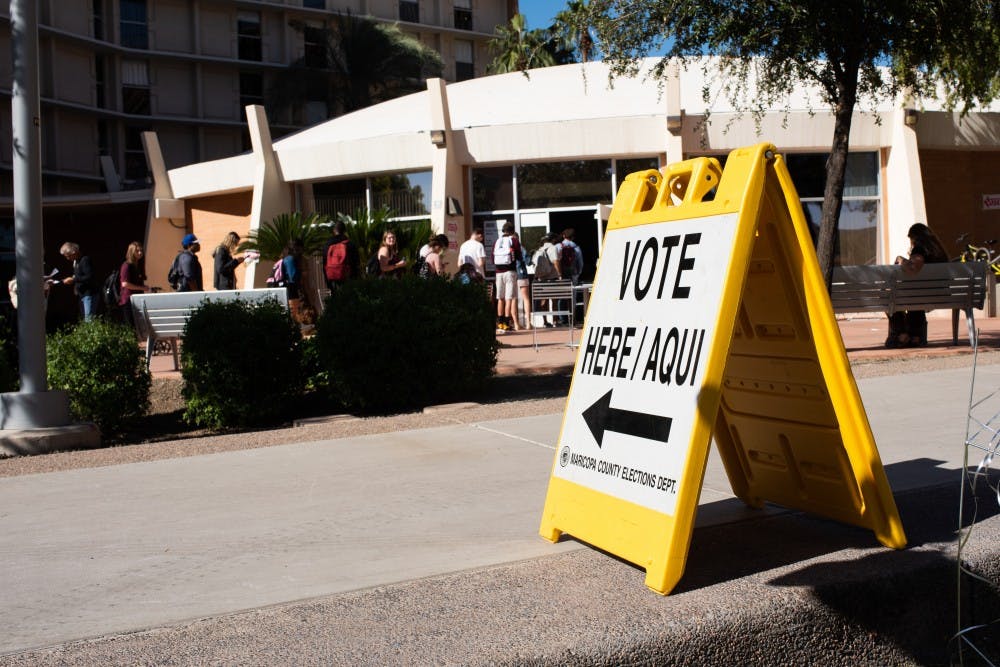Thirty-six million voters across the nation have cast early ballots for the midterm election putting the nation on track to have historic voter turnout by all measures in 2018.
Arizona is no exception, as potentially record-breaking spikes in youth voter registration and early voting have been registered near universities, according to early voter data.
As of Monday, more votes in Arizona have been cast in early voting than the state's total voter turnout during the 2014 midterms, according to Garrett Archer, senior analyst for the Arizona Secretary of State Office who's also known as the "Arizona elections data guru."
Archer said the state will definitely see a record voter turnout based on the widespread increases in voter registration. Turnout percentage is also set to close in on record-setting territory, he said.
“Every year it seems that early voting gets more and more popular among the electorate,” Archer said. “It is a massive component of our election system here.”
Arizona is among the 34 states as well as the District of Columbia permitting no-excuse early voting, and in Arizona, early voting begins 26 days before an election and ends the Friday before election day, according to the National Conference of State Legislatures.
Over 75 percent of the election in Arizona is conducted by mail-in ballots, and Archer said the popularity and ease of early and absentee voting in Arizona draws attention from election observers and voters across the state. The excitement surrounding these midterms adds to the already increasing number of voters who vote early, he said.
“We are just seeing so much more interest this year than we would see in normal turnout — both parties seem to be very much engaged,” Archer said.
Complementing turnout increases across the board, young Arizona voters from ages 18 to 29 are casting votes at triple the rate they did in 2014, according to data aggregated by TargetSmart.
The data shows voters aged 18 to 29 have increased early voting turnout by 186 percent in 2018.
Additionally, the younger demographic of voters, which historically has a poor reputation for voter turnout, already cast over 112,000 votes as opposed to 39,269 in the 2014 midterms comparatively.
Traditionally, pushes targeting university-age voters result in major spikes in voting registration in precincts with universities, Archer said.
“I saw spikes of 1000 percent in some precincts of registration increasing surrounding universities and those people do go out to vote,” he said.
Maricopa County, containing ASU, the state's largest university, is up by over 100,000 voters compared to voter turnout in 2014, according to Archer.
Sarah Landers, a senior studying political science and a NextGen organizer, was sitting outside ASU’s Palo Verde East on Monday morning encouraging students to vote on Election Day.
“For the last week we have been hanging out here outside PV East talking to students and answering any questions about election day,” Landers said. “We were encouraging as many students as possible to early vote, so they don’t have to wait in line on Election Day.”
Landers said she was excited to see a line out of the door when she went to drop off her early ballot.
“For me, it is so exciting to see so many students ready to go vote,” she said.
After spending a large amount of time encouraging and educating other students about early voting and doing so herself, she said the difference between this election and others she has participated in is the buzz of the election among a younger demographic.
“Everyone seems much more excited about this election and ready for representatives that are going to represent their beliefs,” she said. “I think there are going to be a lot more young people turning out to vote than most people think.”
David Wells, a senior lecturer of interdisciplinary studies and political science on ASU’s downtown Phoenix campus, also said early voting increases across the board show estimates on younger voter turnout may be inaccurate.
“Most of the polling I have been looking at presumes 18 to 29-year-olds only represent about 10 to 12 percent of the total voting population, but it is my sense that is an underestimate,” Wells said. “I think it may be off by a few percentage points of what the actual turnout will be on election day.”
Wells said increases in the turnout of younger voters show a positive outlook for the Democratic Party.
“People who are younger are more likely to vote Democrat than Republican, so the early voting numbers seem to be a good indicator of how the Democratic candidates might do in the state, although, it doesn’t determine whether they will win,” Wells said.
Patterns emerging from early voting indicate a momentum in the Democratic Party as the conventional trends of Republicans doing well at the beginning and Democrats closing the gap throughout early voting played out in an “extreme nature” in this election, Archer said.
“All measures from the early voting numbers indicate it is going to be a historic turnout on election day,” Wells said.
Reach the reporter at goldham@asu.edu and follow @graceoldham123 on Twitter.
Like The State Press on Facebook and follow @statepress on Twitter.




